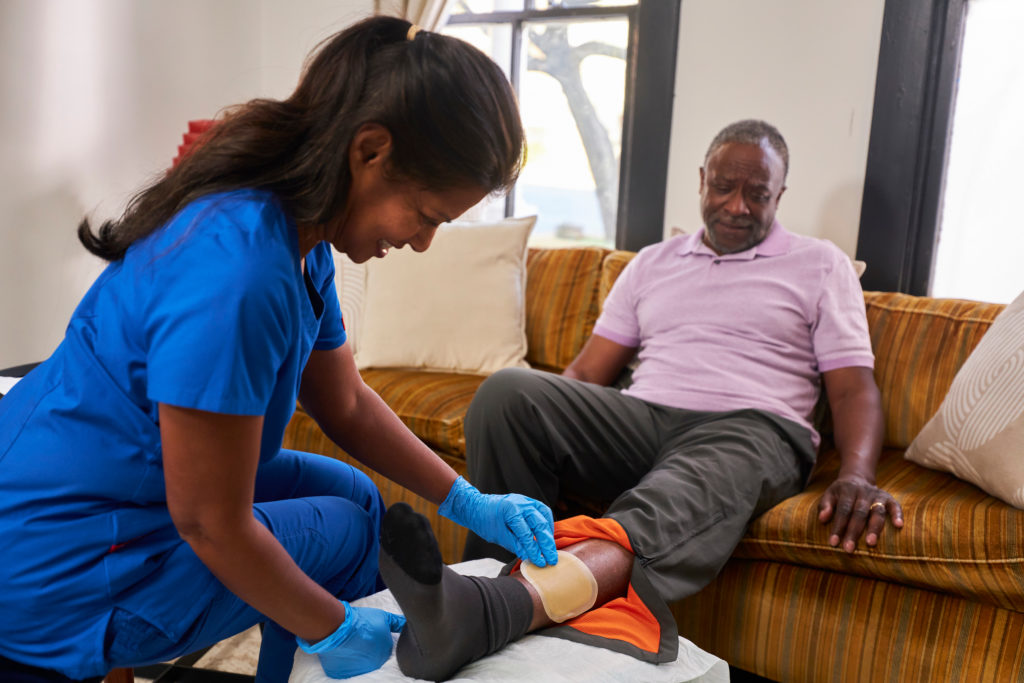The concept of "home" is evolving into a crucial setting for recovery and well-being. Home wound care, an integral facet of this paradigm shift, plays a pivotal role in extending medical care beyond the confines of hospitals.
In this blog we delve into the nuances of wound care in home settings, recognizing its significance in fostering healing journeys for individuals confined to the comfort of their homes.
Understanding the Basics of Bedside Wound Care in Home Settings
Effective wound care in home settings requires a comprehensive understanding of various wound types and the factors influencing their healing process.
A. Different Types of Wounds
Surgical Incisions: Managing wounds from surgical procedures demands specific care to prevent infections and promote optimal healing.
Pressure Ulcers (Bedsores): Bedridden patients are susceptible to pressure ulcers, making prevention and early intervention crucial for home care.
Abrasions and Cuts: Everyday injuries like abrasions and cuts necessitate proper cleaning, dressing, and monitoring to avoid complications.
B. Factors Influencing Wound Healing
Nutrition and Hydration: Adequate nutritional support and hydration are pivotal for the body's ability to repair and regenerate tissues.
Immobility and Positioning: Homebound individuals face challenges related to immobility, emphasizing the need for strategic positioning and movement to prevent pressure ulcers.
Underlying Health Conditions: Chronic illnesses can impact the pace of wound healing, requiring tailored care strategies in a home setting.
Navigating the nuances of wound care in home settings involves addressing these diverse wound types and considering the unique challenges posed by the home environment.
Essential Supplies for Bedside Wound Care in Home Settings
In the realm of wound care in home settings, having a well-equipped home wound care kit is fundamental.
A. Creating a Home Wound Care Kit
Sterile Dressings and Bandages: Stocking sterile dressings and various bandages ensures that wounds are protected from external contaminants, promoting a clean healing environment.
Antiseptic Solutions: Including antiseptic solutions in the kit allows for proper wound cleaning, reducing the risk of infections in a home setting.
Wound Measuring Tools: Precise measurement of wounds is vital for monitoring progress. Tools like rulers or specialized wound measuring devices aid in accurate assessment.
First Aid Supplies: A comprehensive home wound care kit should encompass general first aid supplies such as adhesive tape, scissors, tweezers, and disposable gloves for safe and effective wound management.
Creating a well-organized and accessible home wound care kit caters to the immediate needs of patients, ensuring that caregivers can respond promptly to any wound care requirements.
Challenges and Considerations for Bedside Wound Care
Navigating the landscape of wound care in home settings brings forth distinct challenges that require careful consideration and tailored solutions.
A. Addressing Wound-Related Pain: Managing pain associated with wounds is paramount in home settings. Caregivers must explore appropriate pain relief options, considering factors like the type and severity of the wound, as well as the individual's pain tolerance.
B. Tailoring Care to Bedridden Individuals: Bedridden individuals pose unique challenges in wound care. Adapting strategies to accommodate immobility, such as frequent repositioning and specialized support surfaces, is crucial for preventing pressure ulcers and ensuring optimal healing.
C. Seeking Professional Guidance and Intervention: While providing care at home, it's imperative to recognize when professional guidance is needed. Timely consultation with healthcare professionals ensures that wounds are assessed accurately, and appropriate interventions are implemented for effective wound healing.
Addressing these challenges with a focus on the specific needs of individuals in home settings contributes to a more comprehensive and compassionate approach to wound care.
Conclusion
In conclusion, effective wound care in home settings demands a nuanced approach. From understanding diverse wound types to assembling a well-equipped care kit, caregivers must navigate challenges like addressing pain and tailoring care for bedridden individuals. Seeking professional guidance when needed is crucial. This holistic approach ensures that home-based wound care is not just a necessity but a compassionate practice promoting healing and well-being in the comfort of one's home.



.webp)

.avif)